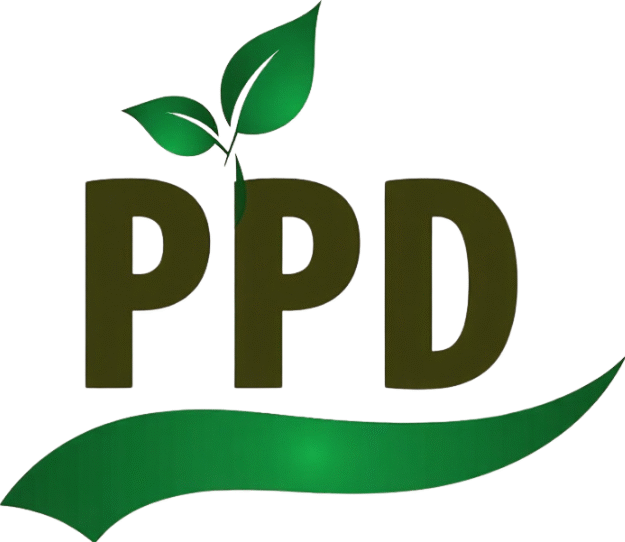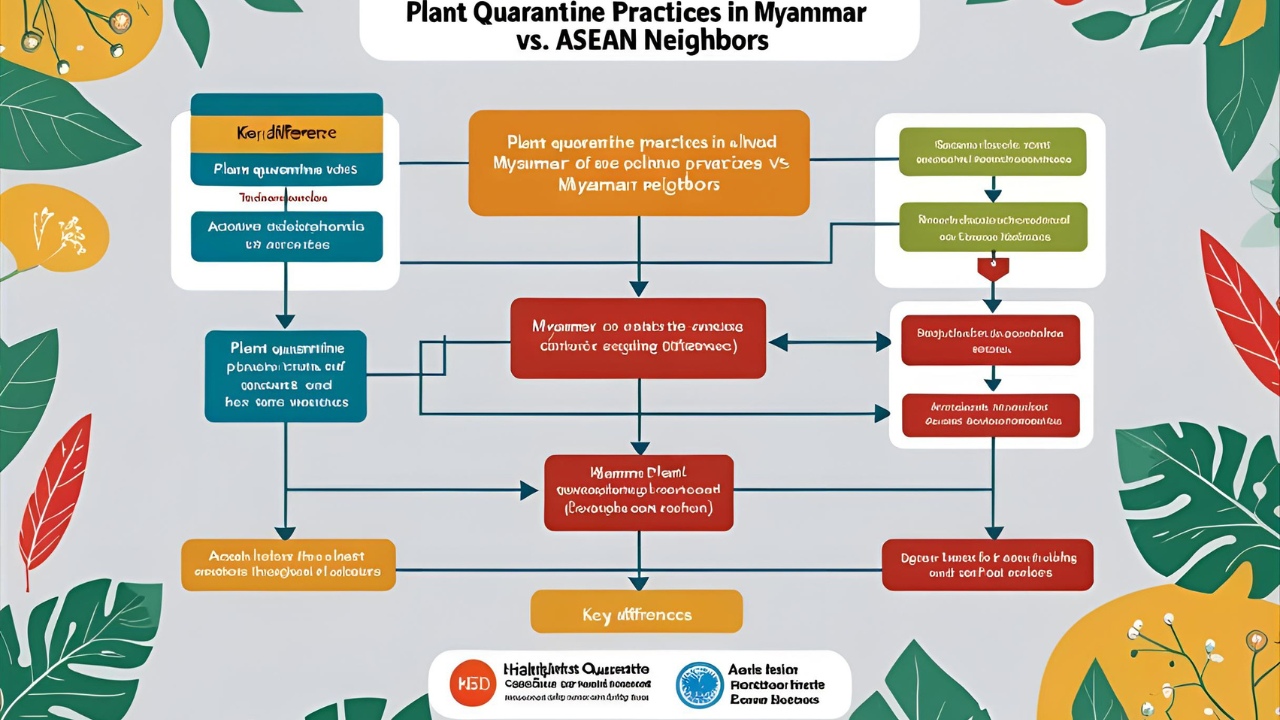
Introduction
As agricultural trade expands across Southeast Asia, the risk of introducing invasive pests and plant diseases has grown significantly. Effective plant quarantine systems are essential to safeguarding biosecurity, ensuring compliance with international standards, and protecting local ecosystems. This article presents a comparative study of plant quarantine practices in Myanmar and its ASEAN neighbors, examining policies, infrastructure, surveillance methods, and regional cooperation. By understanding where Myanmar stands in the regional context, we can identify strengths, gaps, and opportunities for improvement.
What Is Plant Quarantine?
Plant quarantine refers to regulatory measures designed to prevent the introduction and spread of harmful plant pests and pathogens through the movement of plants, plant products, and other related materials. These measures are enforced at borders, ports, and inland checkpoints by National Plant Protection Organizations (NPPOs) under international frameworks such as the International Plant Protection Convention (IPPC) and the WTO’s SPS Agreement.
Core Components of a Plant Quarantine System
- Legal Framework: Acts and regulations defining quarantine powers and procedures.
- Inspection & Certification: Processes for import/export inspection, pest identification, and phytosanitary certification.
- Surveillance Systems: Monitoring for pest incursions and host plant health.
- Infrastructure & Labs: Quarantine stations, diagnostic labs, and storage facilities.
- Emergency Response Plans: Protocols for pest incursions or detections.
Myanmar’s Plant Quarantine Framework
Myanmar’s plant quarantine system is managed by the Plant Protection Division (PPD) under the Department of Agriculture. It has made notable strides in recent years through international support and regional collaboration.
Key Features:
- Operates under the Plant Pest Quarantine Law (1993), aligned with IPPC.
- Implements phytosanitary certification for exports and inspection protocols at major ports.
- Has a centralized diagnostic lab in Yangon and regional quarantine posts.
- Engaged in regional surveillance programs such as ASEAN Fruit Fly Project and FAO-IPPC collaborations.
However, gaps persist in infrastructure, pest database development, digitalization, and rapid response readiness.
Comparative Highlights: Myanmar vs. ASEAN Neighbors
| Component | Myanmar | ASEAN Neighbors (e.g., Thailand, Malaysia, Vietnam) |
|---|---|---|
| Legal Framework | Outdated 1993 law; under review | Modern laws revised post-2000, aligned with WTO and IPPC updates |
| Inspection Points | Limited to major ports and land entries | Broader coverage including minor borders and inland quarantine hubs |
| Diagnostic Labs | Centralized in Yangon | Multiple accredited labs across provinces |
| Digital Systems | Mostly manual records | Integrated e-phytosanitary platforms and mobile pest surveillance |
| Trained Personnel | Improving, but uneven distribution | Stronger NPPO structures with dedicated training centers |
| Regional Engagement | Active in ASEAN forums and FAO projects | Same, with additional bilateral agreements and pest surveillance units |
Areas Where Myanmar is Catching Up
1. Export Certification Services
- PPD has streamlined phytosanitary certification services in line with IPPC standards.
- Gradual introduction of electronic certification systems (ePhyto).
2. International Cooperation
- Myanmar participates in ASEAN harmonization of pest lists and quarantine procedures.
- Training and capacity-building through FAO, JICA, and regional NPPOs have improved skills.
3. Pest Surveillance Initiatives
- Active participation in cross-border surveillance projects like the GMS (Greater Mekong Subregion) plant health monitoring.
Areas Requiring Further Strengthening
| Area | Key Gaps |
|---|---|
| Infrastructure | Need for more regional quarantine posts and mobile labs |
| Legal Reforms | The 1993 law needs urgent updating to reflect international best practices |
| Human Resource Capacity | Inconsistent training across states and regions |
| Public-Private Engagement | Low awareness among traders and farmers about quarantine requirements |
| Pest Risk Analysis (PRA) | Limited integration of PRA in import decision-making |
Overview Table: Myanmar vs. ASEAN Plant Quarantine Practices
| Feature | Myanmar | Thailand | Vietnam | Malaysia |
|---|---|---|---|---|
| Year of Last Legal Revision | 1993 (under review) | 2018 | 2015 | 2016 |
| No. of Quarantine Stations | ~30 | ~80 | ~60 | ~70 |
| e-Phytosanitary System | Pilot phase | Fully operational | Partially operational | Fully operational |
| Accredited Diagnostic Labs | 1 central, few regionals | >5 national labs | >4 national labs | >6 national labs |
| PRA Implementation | Developing stage | Fully integrated | Moderately integrated | Fully integrated |
| Border Pest Surveillance | Periodic | Continuous with reporting tools | Continuous | Continuous with mobile tools |
Lessons Myanmar Can Learn
- Update and Harmonize Legal Frameworks: Aligning laws with regional standards ensures trade compatibility and rapid action protocols.
- Invest in Digital Tools: Emulating Malaysia and Thailand’s use of e-certification and pest tracking tools can modernize Myanmar’s system.
- Decentralize Laboratory Support: Increasing regional labs reduces diagnostic delays and improves early pest detection.
- Enhance Stakeholder Training: Better outreach to farmers, exporters, and customs agents improves compliance and awareness.
- Strengthen Regional Agreements: Expanding bilateral pest surveillance and information exchange will enhance regional phytosanitary safety.
Moving Toward Regional Integration
ASEAN aims to create a harmonized phytosanitary space under initiatives such as the ASEAN Standards for Phytosanitary Measures (ASPM). Myanmar’s full integration into these frameworks can reduce non-tariff barriers, promote safer trade, and enhance national food security.
A coordinated ASEAN plant quarantine strategy, with Myanmar as an active contributor, will help the region face shared threats such as climate-induced pest migration, cross-border infestations, and biosecurity breaches.
3 Best One-Line FAQs
Q1. How does Myanmar’s plant quarantine compare with other ASEAN countries?
Myanmar is progressing but still lags behind in digital tools, lab infrastructure, and legal modernization.
Q2. Why are plant quarantine laws important for trade?
They prevent pest introductions and ensure compliance with international export/import standards.
Q3. What can Myanmar do to improve its plant quarantine system?
It should modernize legal frameworks, expand lab access, and digitize inspection and certification processes.

